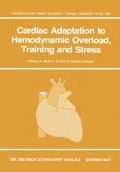Summary
Clinical studies have demonstrated that the unstable or primary angina attacks are caused by severe spastic occlusion of morphologically healthy or partially sclerotic segments of coronary vessels. The suggestion, expressed by some authors, that these spasms may be induced by hypomagnesemia is controversial. The present in-vitro experiments, carried out in isolated strips of coronary vessels (dogs and pigs) and other peripheral blood vessels (bovine facial arteries and veins) do not contradict the conclusion that the increase in basal tone observed after treatment of the vessel preparations with magnesium-free physiologic solutions may possibly represent one triggering factor for the induction of vasospasms, but they favour the concept that these spasms are primarily due to rhythmic contractions initiated by potential pacemaker cells occurring in the wall of the coronary vessels after degenerative processes. They show furthermore that an elevation of Mgo (from 0.5 to 10 mmol/1) can reduce significantly the basal, physiologic tone as well as the tone resulting from an increased transmembrane Ca-ion movement taking place during membrane depolarization or after receptor stimulation. Since magnesium probably represents the most adequate blocker of calcium fluxes, there seems to be no argument against its prophylactic and therapeutic use.
Access this chapter
Tax calculation will be finalised at checkout
Purchases are for personal use only
Preview
Unable to display preview. Download preview PDF.
References
Abraham, A. S., U. Eylath, M. Weinstein, E. Czaczkef: Serum magnesium levels in patients with acute myocardial infarction. New Engl. J. Med. 296, 862 (1977).
Buda, A. J., R. E. Fowles, J. S. Schroeder: Coronary artery spasm in the denervated transplantated human heart. A clue to underlying mechanisms. Amer. J. Med. 70, 1144–9 (1981).
Clark, D. A., R. A. Quint, R. L. Mitchell, W. W. Angell: Coronary artery spasm. Medical management, surgical denervation and autotransplantation. J. Thorac. cardiovasc. Surg. 73, 332 (1977).
Dyckner, T.: Serum magnesium in acute myocardial infarction. Acta Med. Scand. 207, 59 (1980).
d’Hemecourt, A., R. Detar: Possible physiological basis for locally-induced “spasm” of large coronary arteries. In: Maseri, A., G. H. Klassen, M. Lesch, eds.: Primary and secondary angina pectoris, Grune and Stratton Inc. (New York 1978).
Ellis, E. F., O. Oelz, R. L. Jackson: Coronary arterial smooth muscle contraction by a substance released from platelets: Evidence that it is thromboxane A2. Science 193, 1135–7 (1976).
Fleckenstein-Grün, G., A. Fleckenstein: Calcium-Antagonismus, ein Grundprinzip der Vasodilatation. In: Calcium-Antagonismus, A. Fleckenstein, H. Roskamm, eds, p. 196, Springer-Verlag (Berlin-Heidelberg-New York, 1980).
Ginsburg, R., M. R. Bristow, D. C. Harrison, E. B. Stinson: Studies with isolated human coronary arteries. Some general observations, potential mediators of spasm, role of calcium antagonists. Chest 78, 180–6, Suppl. (1980).
Golenhofen, K.: Activation mechanisms in smooth muscle of human coronary arteries and their selective inhibition. Naunyn-Schmiedeberg’s Arch. Pharmacol. 302, R36, Suppl. (1978).
Hellstorm, H. R.: The injury-spasm (ischemia-induced hemostatic vasoconstrictive) and vascular autoregulatory hypothesis of ischemie disease. Resistance vessel-spasm hypothesis of ischemic disease. Amer. J. Cardiol. 49, 802–10 (1982).
Johnson, C. J., D. R. Peterson, E. K. Smith: Myocardial tissue concentrations of magnesium and potassium in men dying suddenly from ischemie heart disease. Amer. J. Clin. Nutr. 32, 967 (1979).
Kawasaki, K., K. Seki, S. Hosoda: Spontaneous rhythmic contractions in isolated human coronary arteries. Experientia 37, 1291–2 (1981).
Langendorff, O.: Über die Innervation der Koronargefäße. Zentralbl. Physiol. 21, 551–57 (1907).
Levy, R. L., L. Wiener, P. Walinsky: Thromboxane release during pacing-induced angina pectoris: possible vasoconstrictor influence on the coronary vasculature. Circulation 61, 1165–71 (1980).
Maseri, A., R. Mimmo, S. Chierchia: Coronary artery spasm as a cause of acute myocardial ischemia in man. Chest 68, 625 (1976).
Nguyen Duong Hoang, R. Rüdel, U. Voss: Effects of AR-L-115 on arterial and venous muscle tone in vitro. Arzneim.-Forsch./Drug Res. 31, 197–9 (1980).
Nguyen Duong Hoang, K. Brecht: Experimentelle Studien über die Wirkung von Magnesium auf isolierte Blutgefäße und ihre therapeutischen Aspekte. Magnesium-Bulletin 2, 33–41 (1980).
Nguyen Duong Hoang, K. Brecht: Über die Wirkung von Magnesium-Ionen auf isolierte Blutgefäße und ihre therapeutische Bedeutung bei Koronarspasmen. Med. Welt 32, 964–6 (1981).
Ross, G., E. Stinson, J. Schroeder, R. Ginsburg: Spontaneous phasic activity of isolated human coronary arteries. Cardiovasc. Res. 14, 613–8 (1980).
Turlapaty, P. D. M. V., B. M. Altura: Magnesium definiciency produces spasms of coronary arteries: relationship to etiology of sudden death ischemie heart disease. Science 208, 198–200 (1980).
Author information
Authors and Affiliations
Editor information
Editors and Affiliations
Rights and permissions
Copyright information
© 1983 Dr. Dietrich Steinkopff Verlag, GmbH & Co. KG, Darmstadt
About this paper
Cite this paper
Duong, N., Brecht, K. (1983). Magnesium as the physiologic calcium antagonist: its vascular effects and therapeutic use. In: Jacob, R., Gülch, R.W., Kissling, G. (eds) Cardiac Adaptation to Hemodynamic Overload, Training and Stress. Steinkopff. https://doi.org/10.1007/978-3-642-85326-5_40
Download citation
DOI: https://doi.org/10.1007/978-3-642-85326-5_40
Publisher Name: Steinkopff
Print ISBN: 978-3-642-85328-9
Online ISBN: 978-3-642-85326-5
eBook Packages: Springer Book Archive

